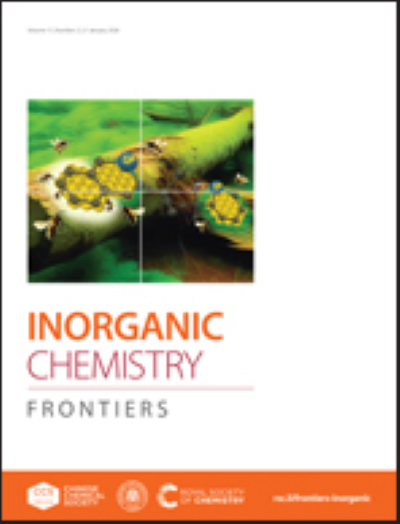(CN4H7)2SO4·H2O:类kbbf结构的高性能无金属紫外双折射晶体
IF 6.4
1区 化学
Q1 CHEMISTRY, INORGANIC & NUCLEAR
引用次数: 0
摘要
高质量紫外双折射晶体材料的研制是推动光电功能晶体技术发展的关键。优异的双折射基群是合成满足高性能光学要求的目标晶体所不可缺少的。本研究选择了具有较宽HOMO-LUMO间隙和较大极化率各向异性的[CN4H7]+基团。此外,通过在分子水平上修饰KBe2BO3F2 (KBBF)模板结构,成功合成了首个无金属硫酸盐(CN4H7)2SO4·H2O。该晶体有效地平衡了短紫外截止边(212 nm)和大双折射(0.132@546.1 nm)。理论计算表明,[CN4H7]+基团及其良好的排列是大双折射的主要原因。我们的研究表明,将[CN4H7]+基团耦合到四面体框架上可以作为一种有效的方法来设计具有增强光学各向异性的紫外双折射晶体。本文章由计算机程序翻译,如有差异,请以英文原文为准。

(CN4H7)2SO4·H2O: high-performance metal-free ultraviolet birefringent crystal with KBBF-like configuration
The advancement of high-quality ultraviolet (UV) birefringent crystalline materials is pivotal in advancing optoelectronic functional crystal technology. The outstanding birefringent fundamental group is indispensable for synthesizing target crystals that meet high-performance optical requirements. This study selected the [CN4H7]+ group with a wide HOMO–LUMO gap and substantial polarizability anisotropy. Furthermore, by modifying the KBe2BO3F2 (KBBF) template structure at the molecular level, the first metal-free sulfate (CN4H7)2SO4·H2O was successfully synthesized. This crystal effectively balanced the short UV cut-off edge (212 nm) and large birefringence (0.132@546.1 nm). Theoretical calculations indicated that [CN4H7]+ group and its favorable arrangement were primarily responsible for the large birefringence. Our study reveals that coupling the [CN4H7]+ group to tetrahedral frameworks serves as an effective approach to engineering UV birefringent crystals with enhanced optical anisotropy.
求助全文
通过发布文献求助,成功后即可免费获取论文全文。
去求助
来源期刊

Inorganic Chemistry Frontiers
CHEMISTRY, INORGANIC & NUCLEAR-
CiteScore
10.40
自引率
7.10%
发文量
587
审稿时长
1.2 months
期刊介绍:
The international, high quality journal for interdisciplinary research between inorganic chemistry and related subjects
 求助内容:
求助内容: 应助结果提醒方式:
应助结果提醒方式:


